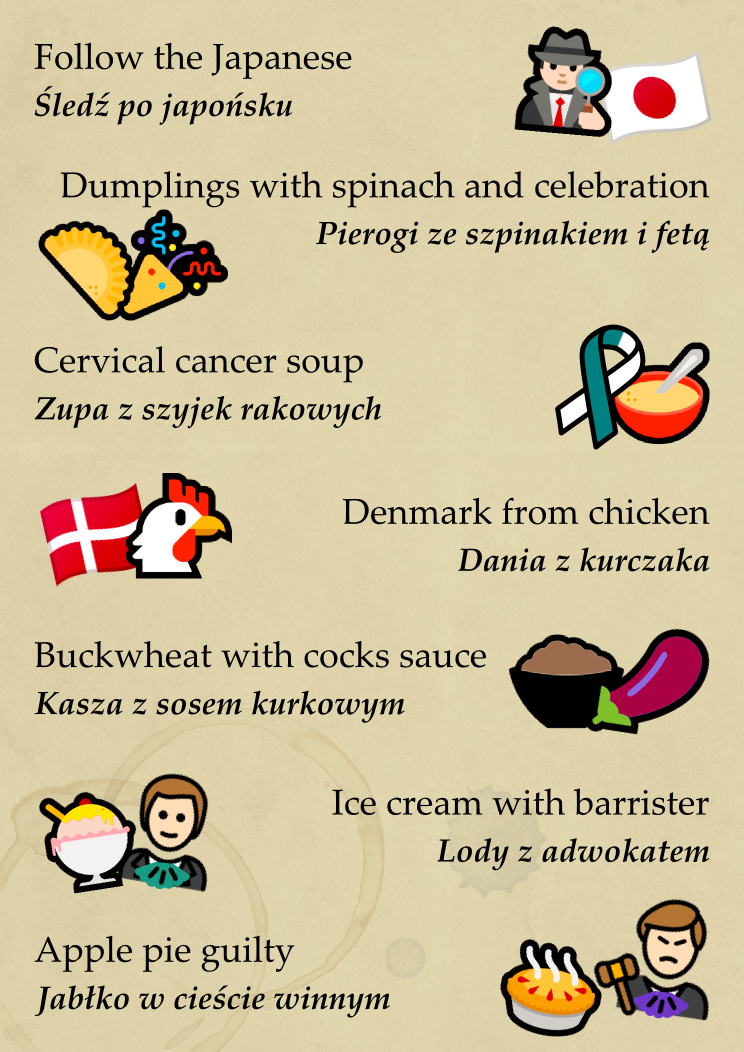A Menu Lost in Translation
On this first day of April, I'd like to propose a special dinner menu composed entirely of authentic Polish specialities. All of these dishes have been gleaned from actual English-language menus of various restaurants across Poland. Enjoy!

|
Oops, it looks like someone used a machine translator to render the Polish menu into English. Believe it or not, even some relatively upscale restaurateurs do this without even having the menu proof-read by someone who actually speaks English. The results are sometimes hilarious, sometimes just confusing, and some are downright off-putting to any visiting foreign tourist. Again, all of the mistranslations above found their way into actual restaurant menus (though never all at once)!
So, have you figured out what they were supposed to mean? You can type your guesses as comments to this Facebook post. Unless you speak Polish, of course, then you don't need to guess.
And if you're ready to see the correct answers, click "Show actual meanings" below!
Follow the Japanese
Let's start with where the confusion came from. The Polish word "śledź" (pronounced shletch) is the imperative mood of the verb "śledzić", meaning "to follow", "to trace" or "to investigate". But it's also got another meaning, which would be more fitting in this context: it's "herring". So a better translation of "śledź po japońsku" would have been "herring in the Japanese style ". Now what the heck is that?
The Japanese-style herring is a very appetising appetiser that was quite popular in Communist Poland. The recipe largely boils down to wrapping a marinated herring fillet around a hard-boiled egg. Perhaps the idea of wrapping a piece of uncooked fish around something reminded someone of maki sushi rolls, giving rise to its association with Japanese cuisine? Otherwise, this Polish invention has about as much to do with Japan as Hawaiian pizza has to do with Hawaii.
The egg and the fish are typically arranged on a bed of canned green peas laced with mayo and decorated with slices of onions and pickles. The marriage of fishy, salty, sour and fatty flavours means that this simple hors d'œuvre pairs perfectly with a shot of cold neat vodka.
Here's a recipe written in the industrial style reminiscent of the Communist era this delicacy hails from:
Standard itemisation of raw materials for 5 helpings:
Hard-boil and peel the eggs. Strain the peas. Slice the onion and the cucumbers. Mix the peas with some of the mayonnaise and arrange it on a platter or little plates for individual helpings. Wrap the eggs in herring fillets and place on the bed of peas. Decorate with onion slices powdered with paprika, cucumber slices and squirts of mayonnaise. A single helping should weigh 100 g [3.5 oz], including 20 g [0.7 oz] of herring. | ||
| — [1]
Original text:
|
Dumplings with Spinach and Celebration
After the cold starter it's time for a hot one: pierogi ze szpinakiem i fetą, or dumplings with spinach and, um, celebration. Pierogi, the delicious Polish stuffed and boiled dumplings, often go hand in hand with celebration, that's true. One kind, sauerkraut-and-mushroom pierogi, is traditionally served at the Christmas Eve dinner. In fact, the very word "pierogi" comes from "*pirŭ", the Proto-Slavic term for a feast. Pierogi are a celebratory food par excellence.
But the filling for our pierogi is spinach mixed not with fête (or "feta" in Polish), but with feta, the Greek brined cheese. Add some garlic and you're going to have a truly delightful combination. While not as classic as potato-and-cheese, ground-meat or mushroom-and-kraut varieties, spinach-filled pierogi are nonetheless both tasty and popular.
And, well, it could have been worse. After all, it's not only Polish businesses catering to English-speaking patrons that make translation mistakes; the same may happen to U.S. businesses selling supposedly Polish food to Polish Americans. Like the one that confused the Polish words "szpinak" ("spinach") and "spinacz" ("paper clip"). Office-supplies pierogi, anyone?
Cervical Cancer Soup
A British tourist in Poznań who once found another "cervical cancer" dish on the menu had this to say about the experience:
| No one I know has had cervical cancer, but I can imagine that if it had been seen by somebody else, they might have been well upset. As it was, I quickly lost my appetite; the meaning doesn’t exactly encourage you to order anything, does it? |
| — Owen Durray, quoted in: [2]
|
The restaurant's spokesperson said they would be "having a word with [their] translator". Which, I guess, means they would somehow try and talk to Google Translate.
Let's see what happened here step by step. The original Polish name for the key ingredient is "szyjki rakowe" (pronounced SHIY-kee rah-KAW-veh). "Szyjki" could be literally translated as "little necks", but in this case it refers to crayfish tails (although, technically, crayfish have neither tails nor necks, but abdomina). "Rak", the Polish word for crayfish, is also used for most things that the English language calls by the Latin word for "crab", that is, "cancer" – the Zodiac sign and, yes, the disease. And specifically, "rak szyjki macicy", or "cancer of the neck of the womb", is the Polish medical term for cervical cancer. "Szyjki rakowe" and "rak szyjki" may look and sound similar, but the difference in meaning is that between delicious and disgusting.